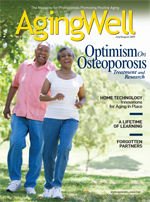July/August 2009 Caring for the Caregiver Kathryn summed it up best after two years of caring for her 60-year-old, once-vital husband who had suffered a massive stroke. Taking him from hospital to outpatient rehabilitation to a necessary, more intensive live-in rehabilitation center, she had to spare some energy for fighting with his insurer to pay for his ongoing medical, rehabilitative, and in-home care. “It is staggering how ill prepared we are for these types of situations,” she said. “The last two years have taught me that the current system of long-term care and connection to needed services and resources is not taking care of what we caregivers and those we are caring for need.” The spouses, children, and other family members, who do and will care for their loved ones, are often left to navigate a bewildering array of services, assuming they know of the options available and are confident of the choices they are being asked to make. Once an individual is confronted with a caregiving imperative along with the sheer emotional and physical toll of caring for a loved one, finding and accessing available resources presents a new challenge. This is compounded by the new responsibility of caring for a loved one, coupled with the necessity to find, coordinate, and manage help for legal, financial, medical, transportation, and other needs. Family dynamic issues add complexity to handling these diverse, overlapping, and perhaps contradictory resources. Offering Help For fragile and vulnerable individuals, programs are in place to provide in-home services for daily tasks, respite provisions, and home modifications. Similarly, professional and lay caregiver associations provide plenty of information on the Internet. Hospital discharge planners, area agencies on aging, senior centers, social workers, geriatric specialists, and allied professionals provide local referrals and sources, including caregiver support groups in diverse programs at separate locations. What is missing among these silos of care is an understanding of what the caregiver really needs: recognition and coordination to connect to help. Recognizing the Caregiver While caregivers are deep in the process of caregiving that is, in the end, a labor of love and ultimately emotionally rewarding to know they are doing the right thing, they benefit from morale boosters of concern for their health and well-being and a friendly copilot to navigate the world of special resources needed for such challenges. Rather than emphasizing the caregivers’ burden or victimization or family dramas involved, professionals need to recognize that caregivers want to be acknowledged, understood, and valued as individuals placed in emotionally charged situations in the continuum of their caregiving roles. Caregiving may be a gradually developing role or suddenly thrust on an individual in one catastrophic event. For instance, in the early stages of caregiving, where a loved one is just beginning to need assistance, professionals can offer guidance regarding locally available services, what they will need now and in the months and years ahead, and ways to keep themselves physically and emotionally healthy. With the luxury of time to plan and prepare, professionals can provide links to legal, medical, and other care issues for what lies ahead, beginning with answers to the questions “Where do I start?” “What will I need to do?” and “How do I find out what is available?” Caring for caregivers early on helps strengthen them and the quality of their care. Even the most capable families can benefit from this consultation because they don’t have experience with the new and complex challenges of caregiving and service arrangements. Caregiver Connectivity To demonstrate how this new era of caregiving connectivity may work, Partners in Care is developing Family Care Partnership, a collaboration of local and regional agencies that creates pilot programs in south Los Angeles and in the northeast San Fernando Valley. Providing these connections between professionals, caregivers, and older adults, the physical locations are starting places where individuals can learn what local resources are available, find a care manager, and participate in support groups and individual counseling. Connectivity, as Family Care Partnership aims to promote, represents how professionals can take the next step on behalf of those they serve. Kathryn would have appreciated the benefits. — Jody Dunn is the regional director of Family Care Partnership, a collaborative led by the Partners in Care Foundation based in San Fernando, CA, which develops replicable and sustainable aging well programs in collaboration with local and national funders, agencies, and donors. |

